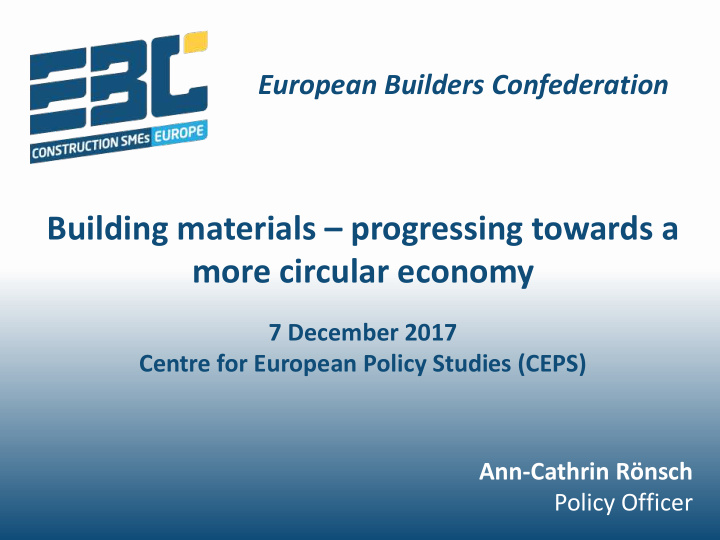



European Builders Confederation Building materials – progressing towards a more circular economy 7 December 2017 Centre for European Policy Studies (CEPS) Ann-Cathrin Rönsch Policy Officer
The Voice of Construction SMEs in Europe 1990 Exclusively representing micro companies & SMEs All the different trades of the construction sector
Economic importance of the construction sector
Structure of the sector
Construction sectors’ impact on waste Total waste generated in the European Union 25-30% construction sector 65-70% other sectors So far the sustainability agenda in construction rather focused on recycling than reuse.
Work done on sustainable construction 65% TC 350 Sustainable Construction works
Innovative construction materials Self-healing concrete Nanomaterials Aerogel Topmix permeable Concrete canvas
Green construction materials Wool Bricks Solar tiles Paper insulation Hempcrete “Sustainable Concrete”
Transition of the building to the circular economy: tasks 1. Demolition and construction site as new engines for the valorisation of materials 3. Exchange on good practices 2. Facilitate the transition from "waste" to "product" 4. Establish a system on the ground
Transition of the building to the circular economy: problems/solutions Good training/qualification Selective demolition needed schemes Number of points authorised to Small craftsman carrying out facilitate the collection of small demolition activities quantities of waste Poor market for recycled Disincentives disposal and aggregates and demolition incentivise the use of recycled materials materials Liability of recycled versus newly- Decrease construction companies’ fabricated products risks to use recycled products
European Builders Confederation Thank you for your attention! ann-cathrin.roensch@ebc-construction.eu www.ebc-construction.eu Twitter: @EBC_SMEs Phone: +32 (0)2 5142323
Recommend
More recommend